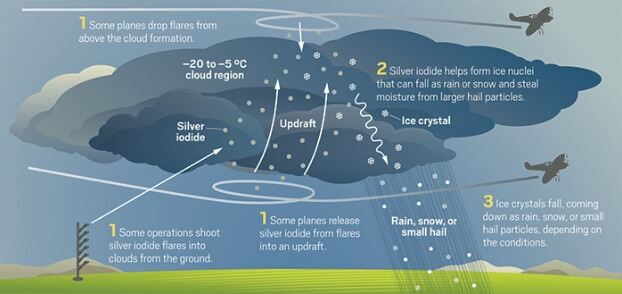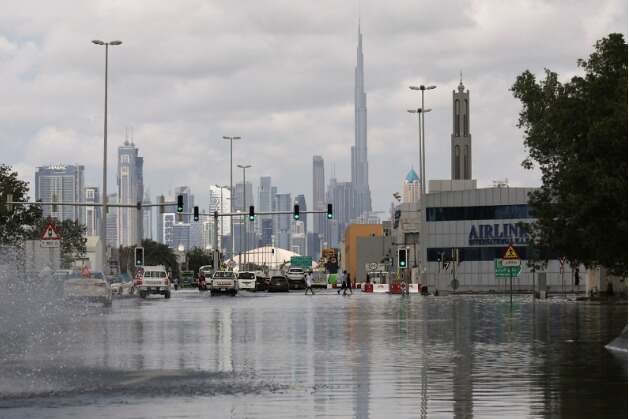Introduction
Dubai floods as relentless rain and storms batter the region from late April 15 onwards. Within hours, the city, renowned for hosting the UN COP-28 in 2023, is submerged underwater. By April 16, the total precipitation reaches 142 mm, exceeding one and a half years’ average rainfall for the area.
Due to water clogging on the roads, the transportation operations were limited. Many flights were diverted as the water entered the airport and the runway, leaving many passengers stranded at the airport. The neighbouring countries face similar problems, with almost 20 casualties in Oman. The rainfall that led to the Dubai floods is the highest recorded rainfall since such data was collected 75 years ago in 1949.
What caused this incessant rainfall and flooding?
The social media and other news platforms are filled with articles providing different causes for the Dubai floods with some blaming cloud seeding for it. Though earlier many sites explained how cloud seeding has caused this havoc, the experts have now debunked the speculations of the Dubai floods being caused by artificial rain or cloud seeding and are pointing at climate change for the same.
What is meant by cloud seeding?
Cloud seeding is a method of producing artificial rain in areas of average low annual rainfall with hot and dry weather. The methodology involves the introduction of chemicals like silver iodide (AgI) which help in the condensation of water vapours on the dust or salt particles present in the atmosphere.
Such dust particles are known as ice nuclei. These ice nuclei provide a base for condensation and without them, the formation of snowflakes or raindrops is not possible, hence no precipitation will occur. The condensed water vapours then form raindrops or crystals of ice and later lead to the formation of clouds. These clouds then cause precipitation in the form of rainfall or hailstorms.
When a cloud system appears over the target region, a small amount of silver iodide is released through aircraft, helicopters, or generators based on the ground. The silver iodide utilized in this technology is present in low concentration and is not known to cause any harmful effects on living organisms when used in such a small quantity.

Can cloud seeding be responsible for this?
Cloud seeding was introduced in the UAE in the 1990s to tackle the problem of water shortage. UAE is one of the leading countries when it comes to using this technology. Though this technology helps enhance the amount of rainfall, it is not capable of causing a flood. The speculations of cloud seeding being the root cause for the Dubai floods rose when some reports of sightings of 6-7 aircraft associated with the cloud seeding program flying over the region surfaced.
- The deputy director general of UAE’s National Center of Meteorology (NCM), Omar Al Yazeedi said that the cloud seeding was done on April 14 and 15 only and not on April 16, and the seeding was not carried out during this incident.
- For cloud seeding operations to be successful, it is a requirement that the seeding needs to be done in the initial stages of clouds before the start of rainfall. In a storm-like condition, such operations cannot be conducted.
Hence experts believe that there is no clear proof indicating that this technology is to be blamed for the current Dubai floods and have cleared all the speculations.
But what is behind this strange weather?
Now that the experts have cleared the air by confirming that cloud seeding is not responsible for the Dubai floods, the actual reason for the same has also been revealed – the changing weather patterns due to climate change. The scientists say that even though the annual rainfall in the region is scanty, it does not occur frequently, instead it occurs as a burst of rain in a severe manner.
The rainy weather was observed in the region last month as well. The rainfall responsible for the Dubai floods is mainly attributed to the atmospheric pressure changes. As stated by a senior forecaster at NCM, the occurrence of high pressure at the upper atmosphere and low pressure at the surface simultaneously leads to colder temperatures at the upper atmosphere and warmer temperatures on the surface. This temperature contrast created the conditions for the thunderstorms.
With the annual rise in temperatures around the world due to global warming, the weather patterns in different regions are also changing. The rising temperatures are causing more ocean water to evaporate, increasing the moisture in the air and increasing the extent of the downpour of rain.
Conclusion
Though the changing weather patterns of the region are the main reason behind the Dubai floods, infrastructure-related issues have worsened the conditions for the public. As these desert regions are not designed to manage floods, the downpour of rain has led to water clogging around the city, halting transportation and disrupting the daily lives of the people as well as animals of the region.
Hence, the people should consider such events as a wake-up call and realize that there is an urgent need to address the issue of climate change, not just in the Gulf region but across the whole world.
– SHIVANGI NAIR
MUST READ: CLIMATE COUNTDOWN: UNDERSTANDING THE URGENCY OF ACTION





